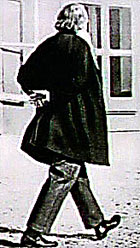The unique history of Japan--that is, the fact that it was a highly advanced culture locked in isolation until 150 years ago--has created a country that is ripe for ideas as it combines those of foreign cultures with its own--and with other foreigners. Up until recently, having seen numerous bizarre combinations coming out of the media of that culture and being fascinated with them, I've been under the impression that there are so many permutations of possibilities that are tried that some of them have to stick eventually, and that is what we are exposed to. While this is still true to some extent, I think that there may be a more concise formula for sparking that magic combination:
Creativity is Crossbreeding Obsessions
What does this mean? It means that, first, only having one obsession will make one a copy-cat. Second, double- or triple- obsessions are meant to intermingle in one's mind. Ideas need to spontaneously meet and cross. Third, it means that the number of obsessions need to be limited in order to allow one to properly obsess about them.
There are many advocates for the process of mentally detoxing for the purpose of creativity, myself included. Bestselling author Tim Ferris has an entire section of his blog devoted to 'email detox' alone. The truth is that most of us fill our lives and our heads with endless noise and activities so that we don't have to worry about the stillness that is there without it. As one who has been through countless periods of existential crises, I can sympathize with this completely: action does help maintain sanity to a point.
But creativity doesn't come from a fully 'sane' mind, I think. I'm personally at my most creative when I'm depressed, manic, obsessive, heart-broken, or exhausted. There seems to be a space inside that opens up and side-lines everything 'important' in favor of that singular creative impulse that drags me into a subconscious state. It's terrifying, because I'm afraid to get into it because I'm afraid to get out of it. When I truly have my mind set on creating something, I don't think about anything else until it's done or I'm so tired that I physically can't continue...and then I dream about it until I wake up and keep going. It's not terribly healthy, but I need it.
My primary obsession is music, obviously. Other obsessions include Japanese culture and language, Zen, the process of learning, and to a lesser extent, things like cooking, nature and dance. I should mention that all of my side obsessions except Japanese were deliberately chosen to compliment and balance my obsession with music and my need to stay healthy. But primarily, I think about music non-stop. I see it in everything: a pattern of grid-streets is interpreted by quarter note chords on a page, or a friend's recent emotional conflict might be interpreted as a rondo or sonata form. These things don't just remind me of their musical equivalents; it's as if I see them overlaid like transparencies. The situation or pattern is its musical counterpoint, for some bizarre reason.
I'm not claiming to be a genius, or even overly creative. I'm merely explaining what goes on in my head, and why I see this hypothesis of reaching the creative inspiration worth looking into. My own life is currently too busy with 'living' to be able to focus as much as I like. I wish to reach a place of stability in my living arrangements such that I can delve into this state of mind regularly.

But living just for this one obsession isn't healthy, nor is it sustainable. That's what the other little obsessions are about. I tend to burn out or reach a place where I can't go any further until my mind settles down. I need things that are relaxing enough to get back on track...which is hard for someone who's as addicted to study as I am. Hence the more physical activities--particularly a good long walk. There are scads of studies that point to taking a walk as being facilitating to creativity, and scads of artists and thinkers who followed the same formula...including my beloved Brahms...
So I believe that when one is so obsessed that one begins seeing things in relation to other things in a completely and bizarrely different way...overlaying to the extent that there is no separation in the representation of those things...truly productive creativity can occur. It's no longer random, and the mind automatically filters through arbitrary connections. We remember things that stand out to us as remarkable. The stronger the connections are, the more we remember them and can work off of them.
Where is all this going? Just back to my original hypothesis: Creativity is crossbreeding obsessions, and this encompasses an entire subset of prerequisites to enable the right way to obsess. Which, I assume, is a life-long pursuit in and of itself.
What do you think? How do you get and keep yourself in a mental space to be creative? Have you found any of these principles for work for you? Let me know in the comments below and I'll be eternally grateful!






